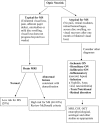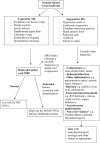Differential diagnosis of suspected multiple sclerosis: a consensus approach
- PMID: 18805839
- PMCID: PMC2850590
- DOI: 10.1177/1352458508096878
Differential diagnosis of suspected multiple sclerosis: a consensus approach
Abstract
Background and objectives: Diagnosis of multiple sclerosis (MS) requires exclusion of diseases that could better explain the clinical and paraclinical findings. A systematic process for exclusion of alternative diagnoses has not been defined. An International Panel of MS experts developed consensus perspectives on MS differential diagnosis.
Methods: Using available literature and consensus, we developed guidelines for MS differential diagnosis, focusing on exclusion of potential MS mimics, diagnosis of common initial isolated clinical syndromes, and differentiating between MS and non-MS idiopathic inflammatory demyelinating diseases.
Results: We present recommendations for 1) clinical and paraclinical red flags suggesting alternative diagnoses to MS; 2) more precise definition of "clinically isolated syndromes" (CIS), often the first presentations of MS or its alternatives; 3) algorithms for diagnosis of three common CISs related to MS in the optic nerves, brainstem, and spinal cord; and 4) a classification scheme and diagnosis criteria for idiopathic inflammatory demyelinating disorders of the central nervous system.
Conclusions: Differential diagnosis leading to MS or alternatives is complex and a strong evidence base is lacking. Consensus-determined guidelines provide a practical path for diagnosis and will be useful for the non-MS specialist neurologist. Recommendations are made for future research to validate and support these guidelines. Guidance on the differential diagnosis process when MS is under consideration will enhance diagnostic accuracy and precision.
Figures




Comment in
-
Guidelines for differential diagnosis of suspected multiple sclerosis.Nat Clin Pract Neurol. 2009 Mar;5(3):134-5. doi: 10.1038/ncpneuro1047. Nat Clin Pract Neurol. 2009. PMID: 19262588
Similar articles
-
Guidelines for differential diagnosis of suspected multiple sclerosis.Nat Clin Pract Neurol. 2009 Mar;5(3):134-5. doi: 10.1038/ncpneuro1047. Nat Clin Pract Neurol. 2009. PMID: 19262588
-
Consensus recommendations for the diagnosis and treatment of multiple sclerosis: 2019 revisions to the MENACTRIMS guidelines.Mult Scler Relat Disord. 2020 Jan;37:101459. doi: 10.1016/j.msard.2019.101459. Epub 2019 Oct 18. Mult Scler Relat Disord. 2020. PMID: 31670208 Review.
-
Consensus recommendations for the diagnosis and treatment of multiple sclerosis: the Middle East North Africa Committee for Treatment and Research In Multiple Sclerosis (MENACTRIMS).Curr Med Res Opin. 2015;31(7):1349-61. doi: 10.1185/03007995.2015.1047750. Epub 2015 May 29. Curr Med Res Opin. 2015. PMID: 25946578
-
Differential diagnosis of suspected multiple sclerosis: an updated consensus approach.Lancet Neurol. 2023 Aug;22(8):750-768. doi: 10.1016/S1474-4422(23)00148-5. Lancet Neurol. 2023. PMID: 37479377 Review.
-
Using atypical symptoms and red flags to identify non-demyelinating disease.J Neurol Neurosurg Psychiatry. 2012 Jan;83(1):44-8. doi: 10.1136/jnnp-2011-300679. Epub 2011 Aug 17. J Neurol Neurosurg Psychiatry. 2012. PMID: 21849338
Cited by
-
MS Prevalence and Patients' Characteristics in the District of Braga, Portugal.Neurol Res Int. 2015;2015:895163. doi: 10.1155/2015/895163. Epub 2015 Jan 8. Neurol Res Int. 2015. PMID: 25642348 Free PMC article.
-
Isolated brain stem lesion in children: is it acute disseminated encephalomyelitis or not?AJNR Am J Neuroradiol. 2013 Jan;34(1):217-20. doi: 10.3174/ajnr.A3176. Epub 2012 Jul 5. AJNR Am J Neuroradiol. 2013. PMID: 22766674 Free PMC article.
-
Brain abnormalities in neuromyelitis optica spectrum disorder.Mult Scler Int. 2012;2012:735486. doi: 10.1155/2012/735486. Epub 2012 Dec 3. Mult Scler Int. 2012. PMID: 23259063 Free PMC article.
-
Diffuse white matter damage is absent in neuromyelitis optica.AJNR Am J Neuroradiol. 2010 Jan;31(1):76-9. doi: 10.3174/ajnr.A1791. Epub 2009 Sep 12. AJNR Am J Neuroradiol. 2010. PMID: 19749224 Free PMC article.
-
Moyamoya Disease May Mimic Multiple Sclerosis?Case Rep Neurol Med. 2019 May 2;2019:1276950. doi: 10.1155/2019/1276950. eCollection 2019. Case Rep Neurol Med. 2019. PMID: 31186973 Free PMC article.
References
-
- Schumacher FA, Beeve GW, Kibler FR, et al. Problems of experimental trials of therapy in multiple sclerosis. Ann NY Acad Sci 1965;122:552–568 - PubMed
-
- Poser CM, Paty DW, Scheinberg LC, et al. New diagnostic criteria for multiple sclerosis: guidelines for research protocols. Ann Neurol 1983;13:227–231 - PubMed
-
- McDonald WI, Compston A, Edan G, et al. Recommended diagnostic criteria for multiple sclerosis: guidelines from the International Panel on the diagnosis of multiple sclerosis. Ann Neurol 2001;50:121–127 - PubMed
-
- Polman CH, Reingold SC, Edan G, et al. Diagnostic criteria for multiple sclerosis: 2005 revisions to the “McDonald Criteria”. Ann Neurol 2005;58:840–846 - PubMed
-
- Charil A, Yousry TA, Rovaris M, et al. MRI and the diagnosis of multiple sclerosis: expanding the concept of “no better explanation”. Lancet Neurol 2006;5:841–852 - PubMed
Publication types
MeSH terms
Grants and funding
LinkOut - more resources
Full Text Sources
Other Literature Sources
Medical

